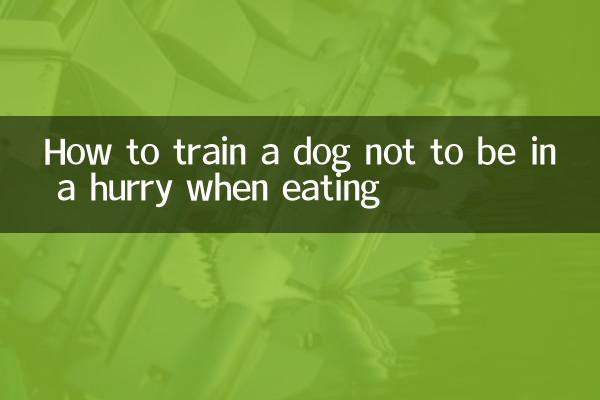How to train a dog not to be in a hurry when eating
Training dogs to take their time eating is a concern for many pet owners. Not only are dogs prone to digestive issues when they gorge themselves on food, but they may also have long-term health consequences. The following is a summary of the hot topics on the Internet in the past 10 days on how to train a dog not to be in a hurry to eat. It combines scientific methods and practical skills to help you solve this problem.
1. Analysis of the reasons why dogs are anxious to eat

A dog's eagerness to eat can be caused by a variety of factors, including nature, competitive pressure, and bad habits. The following are common reasons:
| Reason type | Specific performance |
|---|---|
| nature | Dog ancestors needed to eat quickly in the wild to avoid being robbed of their food |
| competitive pressure | Dogs in multi-pet households are worried about their food being taken away by other pets |
| bad habits | Long-term uncorrected rapid eating behavior |
2. How to train a dog not to be in a hurry when eating
Here are several proven and effective training methods:
| method name | Specific operations | Effect evaluation |
|---|---|---|
| slow food bowl method | Use a special slow food bowl to slow down your eating speed through obstacle design | ★★★★☆ Remarkable effect, suitable for all types of dogs |
| batch feeding method | Divide a meal into 3-4 smaller feedings | ★★★☆☆ Requires more time from the owner |
| Password training method | Teach the "wait" command so your dog can learn restraint | ★★★★★ Best long-term effect |
| barrier feeding | Hide food in toys or obstacles and let your dog eat while playing | ★★★☆☆ Both entertainment effects |
3. Detailed explanation of training steps
1.Preparation: Choose a suitable training time and location and ensure the environment is quiet and free of distractions.
2.basic training: First teach the dog basic commands such as "sit" and "wait" to lay the foundation for eating training.
3.implementation stage:
- Ask the dog to sit and wait
-Slowly lower the food bowl and take it back if the dog becomes restless
- Allow food only if the dog remains calm
- You can interrupt appropriately during the eating process and ask to wait again
4.Consolidate training: Adhere to the same process every day and gradually extend the waiting time.
4. Training Frequently Asked Questions
| question | solution |
|---|---|
| The dog completely ignores the command | Start training with simple passwords and gradually increase the difficulty |
| Dog’s appetite decreases after training | Check whether the pressure is too high and adjust training intensity appropriately |
| Multi-pet family is difficult to implement | Feed separately or train individually using cubicles |
5. Things to note during training
1. Be patient, training may take 2-4 weeks to show results.
2. Avoid training when your dog is particularly hungry, as the effect will be counterproductive.
3. Combined with appropriate exercise, it can help consume the dog’s excess energy.
4. Check your oral health regularly to rule out rapid eating caused by dental problems.
6. Recommendation of auxiliary tools
Here are some aids that are well-received by pet owners:
| product type | Reasons for recommendation |
|---|---|
| slow food bowl | Scientifically designed to effectively slow down eating speed |
| Puzzle feeder | Combine mental games and eating training |
| training clicker | Helps accurately label desired behavior |
Through the above methods and consistent training, most dogs can improve their voracious eating habits within 2-4 weeks. Remember, the key to training is consistency and patience, and don't expect immediate results. Establishing good eating habits is important to your dog's long-term health and is worth your time and effort.

check the details

check the details